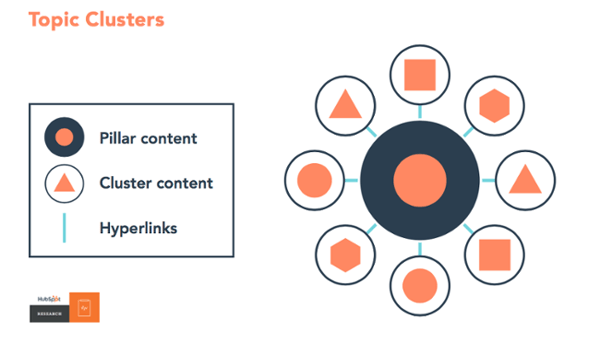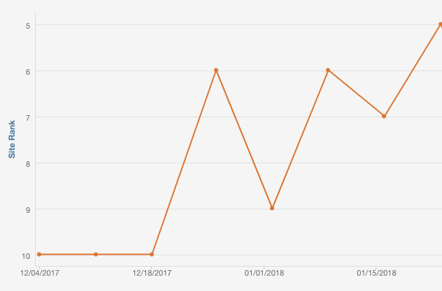
Recently, HubSpot reported a rise in SERP impressions after they implemented strategies to boost internal links. So what is this all about? And why would Google trust internal links as an indicator of site quality? It is all about Topic Clusters and Pillar Pages.
Internal linking and topic clusters are in emerging combined SEO strategy. Topic Clusters are interlinked pages that are all related to a particular topic. Nowadays, you have to focus primarily on site structure and topics instead of keywords implementation for a successful and modern SEO strategy.
This type of architecture focuses on structural shift to lower easier navigation to related content and greater search engine visibility through the use of topics instead of keywords.
HubSpot recommends creating these topic clusters because search engines can easily scan all the content and understand that there is a semantic relationship between the pages’ content.
Are keywords gone forever ?
No, but they don’t carry the same weight that they used to. Old tactics such as keyword stuffing may penalize your website. HubSpot and other digital marketing experts now recommend you write content to cover core topics and subtopics. Focus less on keywords and more on writing pillar pages with relevant content.
We sometimes saw companies and agencies who were great at creating an online presence with keywords, but that doesn’t necessarily means that they were great at providing answers and the content a user actually needed. In response to changing consumer behavior and search engine algorithms, HubSpot launched its Content Strategy Tool.
Keywords still need to be a necessary part of your content strategy and SEO, because they determine what it is you should be writing about and highlight the key terms you are using in your pillar pages. But instead of keyword stuffing and single-word keyword, focus on medium-tail keywords or long-tail keywords.
Persistently developing content strategy is absolutely necessary to combat changes in search method.
Web search is now evolving into more abstract and less specified phrases. Users are and have been hoping Google will recognize there intent. This search method calls for a shift in site structure to accommodate the needs of the user. Direct keyword searches have too many subtle variations to achieve focus search. Instead of a single keyword accessing one page on the website, now a phrase search can reach a topic cluster and a pillar page. This combined with streamlined internal linking can greatly increase the accessibility of your website. This subtle shift in structure allows for a more streamlined architecture and harmony among keywords on the same topic.
The pillar page (long piece of content) is used to navigate to and from topics to long-term keywords through topic clusters. This relates long-term keywords into groups of related content. This allows users find the related content they need more easily and allows a more streamlined process for web crawlers to understand and relate topics on your website.
If you visit HubSpot’s blog, you’ll find an organized content archive that has been bundled into pillar pieces and related topic clusters:

An additional benefit of the structure is that when one of these pages performs well, it is still related to the rest of the top a cluster thus causing a boost in related performance within the group. Topics boost your signal to Google that each individual long-tail keyword in a topic cluster is semantically related to slinking related content more easily and increasing search visibility.
Semantic Search is the focus here.
Google recognizes internal links as being vitally important. Where are you link within your site is an important part of your SEO strategy because it shows Google what content is a priority and what is related.
The structure of these links is similar to an overall topic with subtopics of more specified content branching out from the overall topic. To choose primary or overall topics, simply review the primary landing pages of your site. The subtopics will take a bit more critical analysis. Frequently viewed links are a good place to start. Keep in mind, subtopics are usually designed to continually shift, grow, and adjust with your site. This new SEO strategy of Topic Clusters and Internal Linking will illustrate to Google that you are an authority on your subject. This will help propel you into a primary position in search.
A new strategy to dominate search.
At Revenue River, we’ve been learning in depth all that we can about pillar pages and topic clusters, and understanding how these new methodologies can help the businesses that use our services. Topic clusters mark a change in the way that content marketing is adapting to changes in search engine optimization.
Getting clients started with pillar pieces and topic clusters isn’t that different from executing on a traditional content marketing strategy. In fact, just like SEO, the topic cluster model starts with creating and generation quality content that answers a user’s question. That is why this model makes sense inside an inbound marketing campaign with content strategy. At Revenue River, we use that model to help strategize our client’s content, and provide them with a clear overview of how inbound is going to help their business.
How Topic Clusters get your content on page one of Google Search.
End of 2017, we decided to overhaul our blog’s content strategy and architecture using the new topic cluster methodology. The result ? We saw an incredible rise of Page Rank for our long-tail keyword « Inbound marketing assessment » in Google search results by developing a pillar page and creating internal linking within our relevant blog posts to this pillar page.

Even if you are not following inbound marketing according to HubSpot, you will find an increase in organic traffic by utilizing the new Strategy tool and the topic cluster methodology. By rethinking traditional SEO tactics and focusing content on the needs of the consumer, this strategy is changing the way that agencies will organize content for their client.
At Revenue River, we are here to help you execute on your topic clusters and pillar pieces. Whether you’re seeking pillar content or you would like to set up recurring topic clusters, our content engineers are here to start writing for you, and our search department is here to ensure a proper technical SEO implementation. Take your business into 2018 with a smart content strategy using topic clusters!

